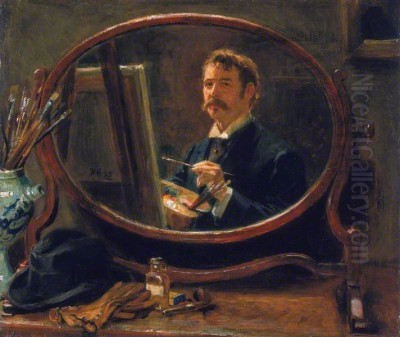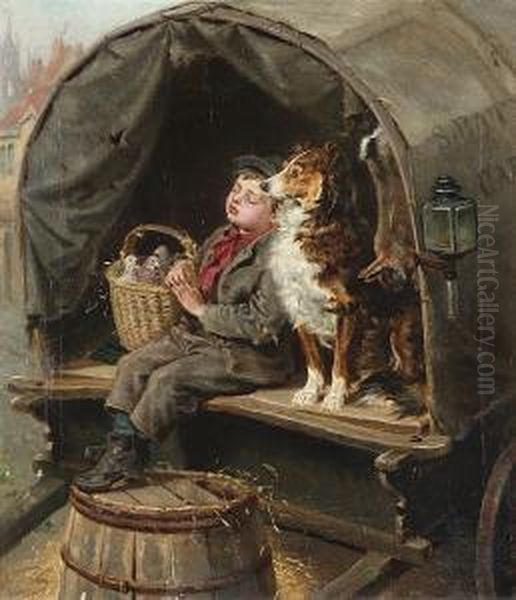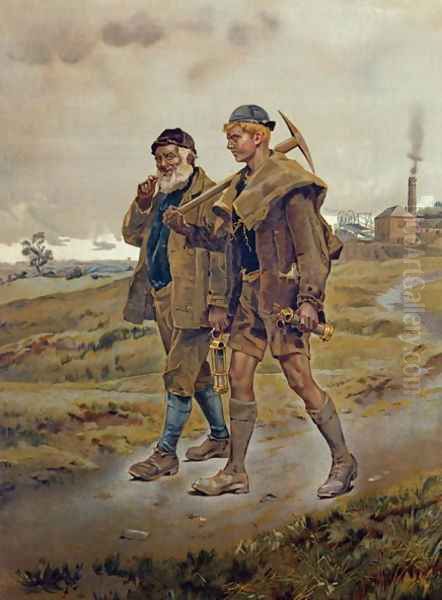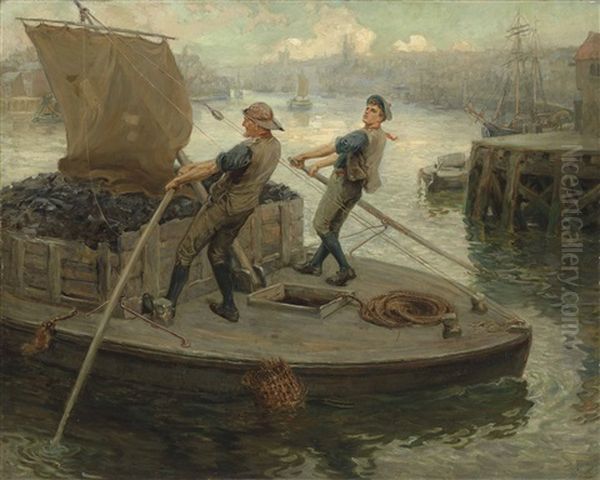
Ralph Hedley stands as a significant figure in British art, primarily celebrated for his realistic depictions of everyday life in the North East of England during the late 19th and early 20th centuries. Born in 1848 and passing away in 1913, Hedley was not only a painter but also a skilled woodcarver and illustrator. His work provides an invaluable visual record of the social fabric, particularly the working-class communities of Tyneside, capturing moments of labour, leisure, and domesticity with honesty and empathy. His commitment to realism, combined with his technical skill across multiple disciplines, secured his reputation both during his lifetime and posthumously, especially within the region he so meticulously documented.
Early Life and Artistic Beginnings
Ralph Hedley's journey began in the village of Gilling West, North Yorkshire, where he was born in 1848. His formative years, however, were spent in Newcastle upon Tyne, after his family relocated there. This move proved pivotal, immersing the young Hedley in the bustling industrial environment of Tyneside that would later become the central focus of his artistic output. His innate talent for art emerged early; by the age of 14, his abilities were recognized with a bronze medal awarded by the government, a significant early encouragement.
Hedley's formal training combined practical craft with artistic study. He undertook an apprenticeship at the carving workshop of Thomas Tweedy. During this period, he not only honed his skills as a woodcarver but also pursued education in art and design. This dual foundation in craft and fine art would characterize his entire career. He began exhibiting his work at the Newcastle Royal Academy of Arts, marking the start of his public career as an artist committed to representing the world around him.
Embracing Realism: The Tyneside Scene

Hedley developed a strong conviction that art held a responsibility to document the lives of ordinary people, particularly the working class. This belief placed him firmly within the Realist movement that gained traction across Europe in the 19th century. His chosen milieu was the North East of England, specifically Tyneside, an area undergoing significant industrial and social change. His paintings moved away from idealized or historical subjects, focusing instead on the tangible realities of contemporary life.
His canvases often depicted miners, shipyard workers, fishermen, families, and street vendors, engaged in their daily routines. Hedley's approach was observational and detailed, aiming to capture the character and atmosphere of the scenes without overt sentimentality, yet often with a quiet dignity. He believed in the inherent value and interest of these subjects, providing a counterpoint to the academic art favoured by established institutions, though he himself would exhibit successfully within them. His work resonated with local audiences who recognized their own lives and communities reflected in his art.
Masterpieces of Everyday Life
Throughout his career, Hedley produced numerous paintings that captured the essence of North East life. His debut at the prestigious Royal Academy in London came in 1879 with The Newsboy, signalling his arrival on a national stage. Other significant works followed, each telling a story of the time. Blinking in the Sun (1880) likely captured a moment of simple observation, perhaps workers taking a break. The Sword Dancers (1880) would have depicted a local custom or festivity, showcasing community traditions.
Paintings like In School (1883) offered glimpses into childhood and education within the community. The Ballad Seller (1884) portrayed a common figure of the urban streetscape, highlighting the popular culture and commerce of the era. The Last in the Market (1885) probably depicted the end of a trading day, focusing on the vendors or remaining customers. Going Home (1888), described as showing two coal miners returning from a pit near Blaydon, became particularly popular for its evocative detail and direct portrayal of working life. Another poignant work, Payday, addressed the hardships faced by workers, depicting an injured miner seeking support from colleagues, a scene reflecting the solidarity and vulnerability within industrial communities. Hedley exhibited prolifically, with over fifty works shown at the Royal Academy between 1879 and 1904.
A Skilled Hand in Wood: The Carver

Parallel to his painting career, Ralph Hedley maintained a successful practice as a woodcarver, demonstrating remarkable versatility. His apprenticeship under Thomas Tweedy laid a strong foundation, and he became highly sought after for ecclesiastical commissions. His most notable carving work can be found in St Nicholas Cathedral in Newcastle upon Tyne. Here, he was involved in creating intricate elements for the choir stalls, including designs and the execution of carvings.
Specific examples of his craftsmanship in the cathedral include finely detailed figures, possibly including representations like a winged lion or griffin, and elaborate wooden arches. His skill extended beyond St Nicholas; Hedley also undertook carving work for St Andrew's Church in Newcastle and various other churches throughout the North East. This aspect of his career underscores his deep connection to traditional crafts and his ability to work masterfully in three dimensions as well as two, contributing significantly to the region's architectural heritage.
Illustrator for the People
Hedley's commitment to depicting everyday life found another outlet in illustration. His images frequently appeared in local newspapers, bringing his art directly to a wide audience beyond the confines of galleries. Furthermore, his work was used commercially, featuring in tea promotions and even cigarette advertisements. This popular dissemination meant his portrayals of North East life became widely recognized and appreciated, particularly among the working-class communities he often depicted.
The accessibility of his illustrations contributed significantly to his local fame and the enduring popularity of his vision. It wasn't just the general public who admired these works; his illustrations were also noted and referenced by fellow artists, indicating their perceived authenticity and artistic merit. Through illustration, Hedley effectively bridged the gap between fine art and popular visual culture, embedding his images into the daily lives of the people in the region.
Exhibitions and Recognition
Ralph Hedley's work was consistently exhibited throughout his career, both regionally and nationally. He was a regular contributor to the Newcastle Royal Academy of Arts from his early years. His national profile was significantly boosted by his frequent acceptance at the Royal Academy in London, where, as mentioned, he showed over 50 paintings between 1879 and 1904. In 1900, he even had a specifically titled exhibition piece there, Ars Longa, Vita Brevis (Art is long, life is short), perhaps reflecting on his dedication to his craft.

Beyond London and Newcastle, his work travelled. In 1891 and 1892, exhibitions featuring his paintings were held in Liverpool, Leeds, and South Shields, further extending his reputation. The Laing Art Gallery in Newcastle became a key venue for celebrating his legacy after his death. Major exhibitions dedicated to his work were held there in 1938 and again in 1990, the latter accompanied by a published catalogue, cementing his status as a major regional artist. More recently, in 2013, his work was featured at the Shipley Art Gallery in Gateshead as part of a festival celebrating the North East, demonstrating his continued relevance and appeal.
Context, Connections, and Comparisons
Ralph Hedley operated within the broader context of 19th-century European Realism. His focus on working-class subjects and detailed observation aligns him with the Social Realism movement. The provided information notes he was influenced by the Newlyn School, a group of artists based in Cornwall who also focused on depicting rural and coastal working life with an emphasis on natural light and everyday scenes. Key figures of the Newlyn School include Stanhope Forbes, Frank Bramley, and Walter Langley, whose works often share a similar sympathetic portrayal of labour and community, though Hedley's focus remained distinctly on the industrial Tyneside environment rather than coastal Cornwall.
His work can also be seen alongside other British artists concerned with social themes, such as Hubert von Herkomer, Frank Holl, and Luke Fildes. These artists often tackled subjects of poverty, labour, and social conditions, sometimes with a more overtly critical or dramatic tone than Hedley's generally quieter observations. An earlier precedent for dignifying labour in British art is found in Ford Madox Brown's famous painting Work.

Internationally, Hedley's realism finds parallels with the French Barbizon School, known for its focus on peasant life and landscape, led by artists like Jean-François Millet. The broader Realist movement championed by Gustave Courbet in France also shares the commitment to depicting contemporary life truthfully. Some scholars, however, note differences between Hedley's style and that of late 19th-century Dutch realists, such as Jozef Israëls (known for his depictions of fisherfolk and rural life), or the Barbizon painters, suggesting Hedley forged his own specific path within the wider movement. The detailed naturalism seen in Hedley's work might also reflect the influence of painters like the Frenchman Jules Bastien-Lepage, whose objective yet sensitive style impacted many artists across Europe. Hedley's dedication to realism stood in contrast to the more polished, idealized subjects often favoured by academic painters like Adolphe William Bouguereau. While influenced by these broader trends, Hedley's unique contribution lies in his specific focus on the people and places of North East England. There is no record of direct collaboration with these specific painters; the connections lie in shared artistic concerns and influences.
Enduring Legacy
Ralph Hedley passed away on June 11, 1913, at the age of 64, leaving behind a rich and varied body of work. His legacy is multifaceted. As a painter, he created an unparalleled visual chronicle of Tyneside life during a period of intense industrial activity and social change. His canvases offer insights into the labours, customs, and domestic scenes of ordinary people, rendered with skill and empathy. His work avoided romanticization, instead offering a grounded, observant perspective that has retained its historical and artistic value.
As a woodcarver, he contributed significantly to the ecclesiastical art and craft of the North East, leaving tangible evidence of his skill in churches and cathedrals, most notably St Nicholas Cathedral in Newcastle. As an illustrator, he brought art into the public sphere, making his images accessible and popular, further cementing his connection with the region. The continued interest in his work, evidenced by major retrospectives at the Laing Art Gallery and other exhibitions well into the 21st century, confirms his enduring importance as a key figure in British regional art.
Conclusion
Ralph Hedley was more than just a painter; he was a visual historian, a craftsman, and a communicator. Through his paintings, carvings, and illustrations, he captured the spirit and reality of North East England in the late Victorian and Edwardian eras. His dedication to Realism, combined with his technical proficiency and deep understanding of his subjects, resulted in a body of work that is both artistically accomplished and socially significant. He gave dignity to the depiction of working-class life and preserved moments of regional culture for future generations. Hedley remains a beloved and respected figure, particularly in the North East, where his art continues to resonate as an authentic and invaluable record of the region's heritage.